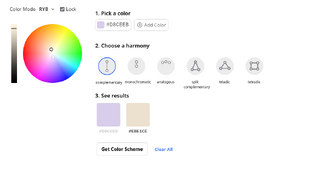Is it possible that the infamous TMax purple antihalation dye didnt fully clear after fixing?
With that in mind: Out of curiosity I went to a site that has a color wheel and I came across something that is making me think. I put in a color that is close to what the dye would look like on T-Max film and then clicked for the compliment color and got pretty darn close to the very same tint that my reversal processed film resembles: Brownish! I was of the thought that the bleach or the clearing bath would be able to take out that dye but from what I just saw from the color example I don't know. I don't know if there is any correlation between the dye and my own results. Is the dye removed, is it being masked, is the bleaching or something else taking the place of where the dye was or am I thinking way out to planet Jupiter?
Maybe there is something to this? Maybe this is the nature of using this combination of development process and type of film or something could be off with my routine. I have thought about bleach issues, washing enough in between the bleach and clearing, am I clearing long enough, is the second development long enough. I read that dichromate tans things such as wood. Does the same apply for films?
Before all of this: I was going to either go with another developer recipe or mix one more batch of PQ concentrate and this time without the potassium bromide in hopes to reduce some warmth. This will make me need to do more exposure testing because the shadows, my guess, are probably going to get more opened Adding benzotriazole isn't phasing the results of the tone but it is starting to show some contrast boost. If I go more with it I might be heading into lith territory. I will be the first on my block to be able to process brown tinted lith transparencies, lol.
I was thinking of going with a variant of the D-19 recipe or Dektol (D-72), grain would be enhanced with D-72 but only for the first development so after the second development the image should look finer, if my thinking is correct.
I am enjoying this process. I think soon I could qualify as a mad chemist, lol.
Update: I know this is black and white film and complimentary colors technically wouldn't apply. I'm just throwing possibilities out there. It is surprising to me seeing the color examples of the purple and the brownish tint.







